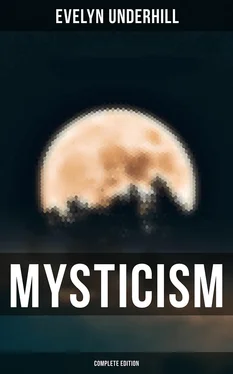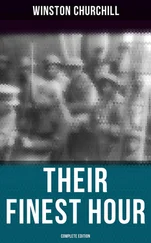Such a criticism of reality is of course the business of philosophy. I need hardly say that this book is not written by a philosopher, nor is it addressed to students of that imperial science. Nevertheless, amateurs though we be, we cannot reach our starting-point without trespassing to some extent on philosophic ground. That ground covers the whole area of first principles: and it is to first principles that we must go, if we would understand the true significance of the mystic type.
Let us then begin at the beginning: and remind ourselves of a few of the trite and primary facts which all practical persons agree to ignore. That beginning, for human thought, is of course the I, the Ego, the self-conscious subject which is writing this book, or the other self-conscious subject which is reading it; and which declares, in the teeth of all arguments, I AM.1 Here is a point as to which we all feel quite sure. No metaphysician has yet shaken the ordinary individual’s belief in his own existence. The uncertainties only begin for most of us when we ask what else is .
To this I, this conscious self “imprisoned in the body like an oyster in his shell,”2 come, as we know, a constant stream of messages and experiences. Chief amongst these are the stimulation of the tactile nerves whose result we call touch, the vibrations taken up by the optic nerve which we call light, and those taken up by the ear and perceived as sound.
What do these experiences mean? The first answer of the unsophisticated Self is, that they indicate the nature of the external world: it is to the “evidence of her senses” that she turns, when she is asked what the world is like. From the messages received through those senses, which pour in on her whether she will or no, battering upon her gateways at every instant and from every side, she constructs that “sense-world” which is the “real and solid world” of normal men. As the impressions come in — or rather those interpretations of the original impressions which her nervous system supplies — she pounces on them, much as players in the spelling game pounce on the separate letters dealt out to them. She sorts, accepts, rejects, combines: and then triumphantly produces from them a “concept” which is, she says, the external world. With an enviable and amazing simplicity she attributes her own sensations to the unknown universe. The stars, she says, are bright; the grass is green. For her, as for the philosopher Hume, “reality consists in impressions and ideas.”
It is immediately apparent, however, that this sense-world, this seemingly real external universe — though it may be useful and valid in other respects — cannot be the external world, but only the Self’s projected picture of it. 3 It is a work of art, not a scientific fact; and, whilst it may well possess the profound significance proper to great works of art, is dangerous if treated as a subject of analysis. Very slight investigation shows that it is a picture whose relation to reality is at best symbolic and approximate, and which would have no meaning for selves whose senses, or channels of communication, happened to be arranged upon a different plan. The evidence of the senses, then, cannot be accepted as evidence of the nature of ultimate reality: useful servants, they are dangerous guides. Nor can their testimony disconcert those seekers whose reports they appear to contradict.
The conscious self sits, so to speak, at the receiving end of a telegraph wire. On any other theory than that of mysticism, it is her one channel of communication with the hypothetical “external world.” The receiving instrument registers certain messages. She does not know, and — so long as she remains dependent on that instrument — never can know, the object, the reality at the other end of the wire, by which those messages are sent; neither can the messages truly disclose the nature of that object. But she is justified on the whole in accepting them as evidence that something exists beyond herself and her receiving instrument. It is obvious that the structural peculiarities of the telegraphic instrument will have exerted a modifying effect upon the message. That which is conveyed as dash and dot, colour and shape, may have been received in a very different form. Therefore this message, though it may in a partial sense be relevant to the supposed reality at the other end, can never be adequate to it. There will be fine vibrations which it fails to take up, others which it confuses together. Hence a portion of the message is always lost; or, in other language, there are aspects of the world which we can never know.
The sphere of our possible intellectual knowledge is thus strictly conditioned by the limits of our own personality. On this basis, not the ends of the earth, but the external termini of our own sensory nerves, are the termini of our explorations: and to “know oneself” is really to know one’s universe. We are locked up with our receiving instruments: we cannot get up and walk away in the hope of seeing whither the lines lead. Eckhart’s words are still final for us: “the soul can only approach created things by the voluntary reception of images.” Did some mischievous Demiurge choose to tickle our sensory apparatus in a new way, we should receive by this act a new universe.
William James once suggested as a useful exercise for young idealists, a consideration of the changes which would be worked in our ordinary world if the various branches of our receiving instruments exchanged duties; if, for instance, we heard all colours and saw all sounds. Such a remark throws a sudden light on the strange and apparently insane statement of the visionary Saint-Martin, “I heard flowers that sounded, and saw notes that shone”; and on the reports of other mystics concerning a rare moment of consciousness in which the senses are fused into a single and ineffable act of perception, and colour and sound are known as aspects of one thing.4
Since music is but an interpretation of certain vibrations undertaken by the ear, and colour an interpretation of other vibrations performed by the eye, this is less mad than it sounds and may yet be brought within the radius of physical science. Did such an alteration of our senses take place the world would still send us the same messages — that strange unknown world from which, on this hypothesis, we are hermetically sealed — but we should interpret them differently. Beauty would still be ours, though speaking another tongue. The bird’s song would then strike our retina as a pageant of colour: we should see the magical tones of the wind, hear as a great fugue the repeated and harmonized greens of the forest, the cadences of stormy skies. Did we realize how slight an adjustment of our organs is needed to initiate us into such a world, we should perhaps be less contemptuous of those mystics who tell us that they apprehended the Absolute as “heavenly music” or “Uncreated Light”: less fanatical in our determination to make the solid “world of common sense” the only standard of reality. This “world of common sense” is a conceptual world. It may represent an external universe: it certainly does represent the activity of the human mind. Within that mind it is built up: and there most of us are content “at ease for aye to dwell,” like the soul in the Palace of Art.
A direct encounter with absolute truth, then, appears to be impossible for normal non-mystical consciousness. We cannot know the reality, or even prove the existence, of the simplest object: though this is a limitation which few people realize acutely and most would deny. But there persists in the race a type of personality which does realize this limitation: and cannot be content with the sham realities that furnish the universe of normal men. It is necessary, as it seems, to the comfort of persons of this type to form for themselves some image of the Something or Nothing which is at the end of their telegraph lines: some “conception of being,” some “theory of knowledge.” They are tormented by the Unknowable, ache for first principles, demand some background to the shadow show of things. In so far as man possesses this temperament, he hungers for reality, and must satisfy that hunger as best he can: staving off starvation, though he many not be filled.
Читать дальше












